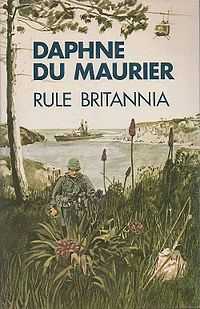Rule Britannia (novel)
| Rule Britannia | |
|---|---|
 1st edition | |
| Author | Daphne du Maurier |
| Cover artist | Keith Richens[1] |
| Country | United Kingdom |
| Language | English |
| Publisher | Victor Gollancz |
Publication date | 1972 |
| Media type | |
| Pages | 215 |
| ISBN | 0-575-01598-5 |
Rule Britannia is Daphne du Maurier's last novel,[2] published in 1972 by Victor Gollancz.[1]
Plot introduction
Set in the late 1970s in Poldrea, a small Cornish village, the novel describes the peaceful existence between the main character, Emma (a young woman living with her grandmother, Mad) that they share with children recruited by the retired famous actress, Mad. One morning, however, Emma wakes up to hear airplanes overhead and a warship in the Cornish harbor. After she and Mad investigate further, they find out that barricades have been set up around the countryside, and find soldiers marching over the fields. After hours of confusion, an announcement is made by the Prime Minister, detailing that a union between the United States of America and the United Kingdom of Great Britain and Northern Ireland was being undertaken, to form the U.S.U.K. (This is a result of a brief background story that the United Kingdom had "boobed" or failed in Europe both economically and with their military). The plan of both nations is to form a union between all English-speaking peoples, such as South Africa, Australia, Britain and America. However, Mad and Emma are sure that the "peaceful union" is not as peaceful as the soldiers and authorities are telling them, and they set out to find out what is really going on.
Dedication
The book is dedicated to actress Gladys Cooper who was one of Daphne's father Gerald du Maurier's leading ladies, and died in 1971. She was the basis for the character 'Mad' in the novel.[3]
References
- ↑ 1.0 1.1 SF Encyclopedia Picture Gallery Retrieved 2013-08-04
- ↑ Rule Britannia by Daphne du Maurier « Pining for the West Retrieved 2013-08-04
- ↑ Introduction, 2004 Virago edition
| |||||||||||